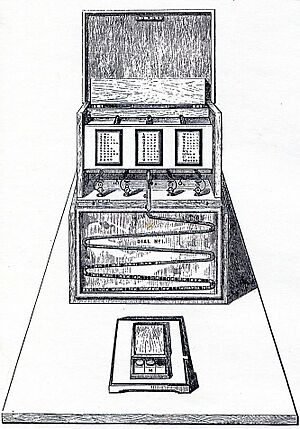Globotype facts for kids
The Globotype was a clever invention from the 1800s used for sending messages. It was a type of color display for telecommunications, which is the science of sending information over long distances.
This unique machine was invented and patented by David McCallum, an inventor from Stonehouse, Devon, England. He received the official patent for his idea on December 29, 1855. The Globotype was special because it was designed to be very cheap to build and run, and it didn't use up supplies like ink or paper.
What Was the Globotype?
The Globotype was a visual telegraph machine. Instead of printing letters on paper, it used colorful balls to spell out messages. The name "Globotype" comes from the word "globe," referring to the small, round balls it used.
The inventor, David McCallum, published a small booklet in 1856 to explain his machine. The full title was: THE GLOBOTYPE TELEGRAPH: A recording instrument, by which small coloured balls are released one-by-one, and made to pass over a series of inclined planes, by the force of their own gravity. This title perfectly describes how the machine worked.
How Did It Work?
The Globotype operated using a simple but brilliant idea: gravity.
- A telegraph operator would send signals over a wire.
- These signals would cause the Globotype machine to release small, colored balls.
- The balls would then roll down a series of ramps, or "inclined planes," inside the machine.
- The person receiving the message would watch the order and color of the balls to understand the message, similar to reading a code.
This method was purely mechanical and visual, making it a unique alternative to other telegraphs of the time.
Why Was It Invented?
In the mid-1800s, many new telegraph machines were being invented. Some of these were printing telegraphs, which could automatically print out messages. However, David McCallum thought these machines were too expensive and unnecessarily complicated.
He believed it was much simpler and more efficient to have a person write down a message than to build a complex machine to print it. He designed the Globotype to be a smart, low-cost solution for sending and receiving messages quickly without the high cost of printing equipment.
See also


